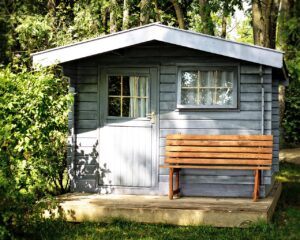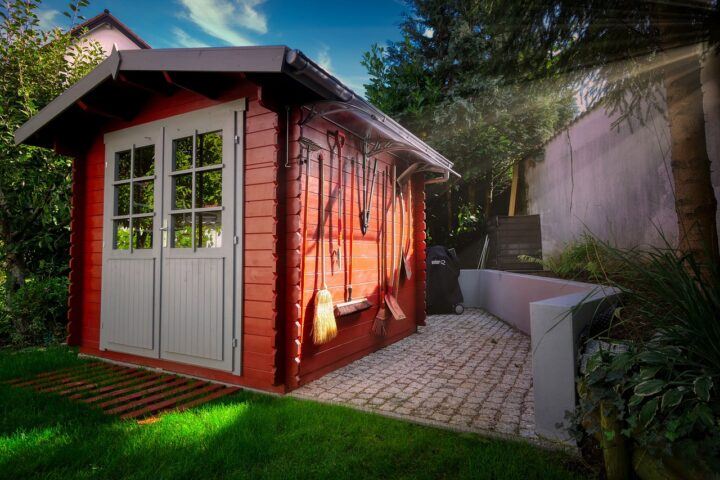Table of Contents
How to Convert a Shed to a Tiny Home: Transform Your Space into a Cozy Haven!
Transforming a shed into a tiny home can be a thrilling project. It offers an affordable way to join the tiny house movement. By converting an existing shed, you can save on construction costs and customize the space to your needs. You’ll discover how you can create a cozy, functional tiny home with minimal investment and lots of creativity. So lets get started on how to convert a shed to a tiny home!

Assessing your shed’s potential is crucial before diving into the project. Consider the shed’s size, structure, and condition to ensure it’s suitable for conversion. Proper planning will help you envision how to turn the space into a comfortable living area, making the most of every square foot.
You’ll need to design the tiny home layout, prepare the shed for conversion, and add finishing touches to the interior and exterior. Sustainable and off-grid living options can also be considered for a more environmentally friendly approach. With careful budget management and a clear plan, your shed can transform into a charming tiny home.
Key Takeaways
- Transforming a shed into a tiny home is cost-effective and customizable.
- Assess your shed and plan the layout for optimal use.
- Interior and exterior enhancements turn the shed into a cozy living space.
Assessing Your Shed’s Potential
Converting a shed into a tiny home involves checking its size, structure, and legal requirements. This helps ensure your shed is ready for transformation.
Evaluating Size and Structure
First, measure your existing shed. Knowing its dimensions is crucial. A tiny home should be at least 100 square feet to provide enough living space. Check the height, width, and length.
Inspect the foundation. A strong foundation keeps your tiny home stable and safe. If needed, consult a professional to reinforce it. Make sure the shed walls and roof are sturdy. Look for any damage, like rot or rust, that could weaken the structure.
The materials of your shed matter, too. Wood sheds provide better insulation than metal ones. Consider the ease of making modifications. Wooden structures are often easier to alter, while metal sheds require specific tools and skills.
Understanding Legal and Permit Requirements
Before converting your shed, research local building codes. Many areas have specific regulations for shed conversions. You may need a building permit. Permits ensure your tiny home meets safety and zoning standards.
Contact your local zoning office. They can provide details on setbacks, maximum height, and other rules. Some places may have restrictions on living in a shed full-time.
Hiring a professional can help navigate these legal waters. They can assist in obtaining necessary approvals and ensuring your conversion follows all guidelines. Ignoring permits can lead to fines or having to undo your work. It’s crucial to get this step right to avoid future headaches.
Designing Your Tiny Home
Designing your tiny home involves creating a cozy and functional layout, selecting a style and decor that reflects your taste, and maximizing light and ventilation for comfort.
Creating a Cozy and Functional Layout
When designing the layout, think about the essential zones you need: a sleeping area, kitchenette, bathroom, and living space. Multifunctional furniture is key. Opt for a sofa bed or a loft bed to save space. Foldable tables and wall-mounted storage can provide much-needed flexibility. Keep pathways clear to ensure easy movement. Consider using sliding doors to save space and enhance flow.
Selecting Style and Décor
Select a style that reflects your personality. Whether you prefer a modern look, rustic charm, or minimalist approach, choose décor elements that make your space feel like home. Light-colored walls can make the space look bigger. Use rugs and cushions to add warmth. Incorporate plants for a touch of nature. Remember, less is more in a tiny home. Stick to a few key pieces to avoid clutter.
Maximizing Light and Ventilation
Good lighting and ventilation are crucial for a comfortable tiny home. Install large windows and skylights to let in natural light. Use sheer curtains to maintain privacy without blocking the light. Add mirrors to reflect light and create an illusion of space. For ventilation, ensure windows and doors can open fully. Install small fans or a compact air conditioning unit to keep the air flowing.
Preparing the Shed for Conversion

Before you can turn your shed into a tiny home, you need to make sure the existing structure is in top shape and properly insulated. This ensures it will be a safe and cozy living space.
Repair and Clean Existing Structures
Start by inspecting the shed for any damages. Look for issues like cracked walls, broken windows, or a leaky roof. Fixing these problems early will save you time and money later. A strong foundation is essential, so make any necessary repairs to ensure the shed is stable.
Next, clean the entire structure thoroughly. Remove any dirt, debris, or pests. Cleaning helps you spot hidden issues like rot or mold. If you find any, deal with them immediately. A clean space is easier to work with, making your conversion process smoother.
Weatherproofing and Insulation Strategies
Weatherproofing is crucial to make your tiny home habitable year-round. Seal any gaps around doors and windows using weather stripping. Apply weatherproofing plastic to windows and sealing foam tape to the bottom panel of windows for extra protection.
Insulation is key to maintaining a comfortable temperature inside your shed. Use proper insulation materials for the walls, floor, and ceiling. You can choose from options like fiberglass, foam board, or spray foam for effective insulation.
Together, these steps will prepare your shed for conversion into a cozy and durable tiny home.
Interior Finishing Touches
Creating a cozy and functional living space inside your tiny home shed involves key processes like installing drywall, adding flooring, and choosing the right furniture and storage solutions.
Drywall Installation and Painting
Start with drywall for smooth and insulated walls. Drywall is an affordable option that adds structure and insulation. Make sure to seal all joints and transitions to keep your space airtight and energy-efficient.
After installing the drywall, choose colors that match your style and make the space feel larger. Lighter shades like white or pastel can make your tiny home feel open and bright. Use semi-gloss or satin paint for easy cleaning and a subtle shine.
Flooring Solutions
When it comes to flooring, durability and ease of installation are key. Vinyl plank flooring is an excellent option because it’s water-resistant and easy to install. It comes in various styles that can resemble wood, stone, or tiles, adding a touch of elegance to your space without the high cost.
Another practical option is laminate flooring, which is both durable and budget-friendly. It’s available in multiple finishes and can give your tiny home a modern, stylish look.
Choosing Furniture and Storage
For furniture, focus on multifunctional pieces that save space. A sofa bed or murphy bed can serve dual purposes, freeing up room during the day. Built-in storage solutions like shelves, cabinets, and under-bed storage make the best use of limited space.
Opt for foldable or stacking furniture that can be easily stored when not in use. Use vertical space for decorative shelves and lighting fixtures. Choose cozy, comfortable furniture to make your tiny home inviting. Try to balance aesthetics with practicality to create a seamless and enjoyable living experience.
Exterior Enhancements
Transforming the outside of your shed into a tiny home involves giving it a fresh look and adding useful features. These changes can make your new home more inviting and functional.
Outdoor Painting and Aesthetics
Painting the shed can be a game-changer! Choose colors that match your taste and the surroundings. Use weather-resistant paint to protect your shed from the elements.
You can also add a splash of color by painting the trim, doors, and windows in contrasting shades.
Think about your backyard: How does your shed fit in? You can add decorative elements like shutters, window boxes, and a fun, stylish door. These touches make your tiny home feel cozy and unique.
Adding lights around the exterior can also create a magical ambience at night. Solar-powered lights are an eco-friendly choice.
Functional and Decorative Elements
Installing gutters helps manage rainwater runoff and keeps your tiny home dry. A simple gutter system can prevent water damage and help direct rainwater away from the base of your shed.
New doors and windows are essential for improving insulation and aesthetics. Choose energy-efficient options to keep your home comfortable in any weather.
Privacy is key, too! Consider planting bushes or adding a privacy fence around your tiny home. These can also add to the overall aesthetic of your backyard.
A small patio or deck can extend your living space outdoors. It’s perfect for relaxing or entertaining guests. Add some comfy outdoor furniture and maybe a little fire pit for cozy nights.
Decorative touches like hanging plants, a welcome mat, and garden ornaments help make your tiny home look inviting and lived-in.
Sustainability and Off-Grid Living
Converting a shed into a tiny home offers fantastic opportunities for sustainable and off-grid living. Incorporate eco-friendly features and plan for energy independence to make your tiny home truly green.
Incorporating Sustainable Features
To make your shed-to-tiny home conversion sustainable, focus on energy efficiency and eco-friendly materials. Start by using insulation to reduce your heating and cooling needs. Choose materials like reclaimed wood or recycled metal for construction. These materials not only look good but also reduce your carbon footprint.
Install a solar power system to harness the sun’s energy for electricity. Solar panels are a great way to stay green and cut down on utility bills. You can also add a composting toilet to manage waste sustainably. These toilets transform human waste into usable compost, reducing water usage and environmental impact.
For water needs, set up a rainwater collection system. Collecting and using rainwater for everyday needs like washing and gardening can be a sustainable choice. Consider a filtration system to make rainwater suitable for drinking. Add low-flow faucets and showerheads to your tiny home to further conserve water and increase efficiency.
Living Off the Grid
Living off the grid in your tiny home involves complete energy independence and self-sufficiency. Equip your home with a reliable solar power setup to generate all the electricity you need. Solar batteries will store excess power for cloudy days, ensuring you never run out of energy.
Water is another essential area to address. A water collection system allows you to rely on natural sources, making your tiny house truly off-grid. Store collected water in tanks and use filters to make it potable. Combine this with a composting toilet to handle waste efficiently without connecting to a sewage system.
Creating an off-grid tiny house also means planning for heating and cooling. Use energy-efficient appliances and consider adding a wood stove or solar heating system to keep your house warm during winter. For cooling, natural ventilation and energy-efficient fans can make a big difference.
By focusing on these sustainable practices, you can enjoy a lifestyle that’s kind to the environment and reduces your reliance on public utilities.
Budget and Financing
When converting a shed into a tiny home, it’s important to consider both the costs involved and the financing options available to make the project affordable. Careful planning helps you stay within budget and achieve your dream home.
Calculating Costs and Setting a Budget
Start by listing all expenses involved in the conversion. This includes the cost of the shed, labor, materials, electrical and plumbing work, and any permits required.
Here’s a breakdown of some common expenses:
| Item | Estimated Cost |
|---|---|
| Shed purchase | $8,000 – $21,000 The Spruce |
| Electrical and plumbing | $3,000 – $8,000 |
| Insulation | $500 – $1,500 |
| Interior finishes | $1,000 – $5,000 |
| Labor | $5,000 – $15,000 |
Setting a budget helps you avoid unexpected expenses. Allocate a contingency fund, about 10% of the total budget, for unexpected costs. Keep track of all expenses and adjust as needed.
Exploring Financing Options
Several financing options can help make your tiny home project more affordable. Personal loans are a popular choice, offering flexible terms and interest rates.
Consider these financing methods:
- Personal Loans: Often, quick approval and flexible terms.
- Home Equity Loans: If you own your home, you can borrow against its value.
- Credit Cards: Useful for smaller purchases; beware of high-interest rates.
- DIY and Savings: Use your savings or complete much of the work yourself to cut costs.
Research various lenders to find the best rates. Some credit unions and banks offer loans specifically for tiny homes. Make sure to read the fine print and understand the terms before committing.
Maintaining Your Tiny Home
Maintaining your tiny home is crucial for longevity and comfort. Routine cleaning and seasonal maintenance will keep your space in top shape, ensuring it’s always a cozy and functional place to live.
Routine Cleaning and Upkeep
Regular cleaning is essential to keep your tiny home comfortable and inviting. Dusting frequently is important as smaller spaces can collect dust more quickly. Don’t forget to wipe down surfaces, including countertops and shelves, at least weekly.
Vacuum often, especially in high-traffic areas. Cleaning floors regularly prevents dirt from building up. In the kitchen, keep appliances like the stove and refrigerator clean to avoid any unpleasant odors or pests.
Check for leaks under sinks and near windows. Regularly inspect door seals and window frames to maintain energy efficiency. Keep clutter to a minimum by sorting through belongings regularly and donating or discarding what you don’t need.
Seasonal Maintenance Tips
Each season brings its own set of maintenance challenges. In the winter, ensure that your tiny home is properly insulated. Check and seal any drafts around windows and doors to keep the cold out and the heat in.
During spring, examine your roof and gutter system. Clean out any debris to prevent water from pooling and causing damage. Also, inspect for any signs of mold or mildew, especially in bathrooms and kitchens.
In the summer, focus on climate control. Clean or replace air filters to keep your HVAC system running efficiently. Additionally, examine outdoor areas for any needed repairs or touch-ups, such as checking the condition of your deck or porch.
When fall arrives, prepare for colder weather by checking your heating system. This is also a good time to inspect and clean your chimney if you have one. Lastly, ensure your exterior is ready for the upcoming storms, including securing any loose items.
By sticking to these routines, your tiny home will remain a comfortable and inviting space all year round.
Frequently Asked Questions
Discover creative ideas, typical costs, essential utilities, inspiring stories, legal details, and design tips for converting a shed into a cozy tiny home.
What are some creative ways to turn a shed into a fully furnished tiny home?
You can transform a shed by adding multi-functional furniture, like a sofa that converts into a bed. Built-in storage units help maximize space. Adding large windows can bring in natural light, making the space feel bigger. Paint the interior with light colors to create an open, airy look.
What are the typical costs associated with converting a shed into a comfortable living space?
Converting a shed typically costs between $45,000 and $50,000. Starting with an existing shed can reduce costs by $8,000 to $21,000, the price range of a new wood shed including delivery. Custom features like windows and accessories will add to the overall budget.
What are the essential utilities and amenities needed for making a shed livable?
You will need water, electricity, and sewage connections. Insulating the shed is crucial for comfort. A simple HVAC system for heating and cooling will make the space livable year-round. Furnishings like a compact kitchen, a bathroom, and proper lighting are also essential.
Can you share inspiring success stories of shed-to-tiny-home conversions?
One inspiring story includes a family who converted a large 12×20 shed into a stylish and functional tiny home. They added custom features and smart storage solutions, making it a cozy and affordable living space. Their story showcases the potential of tiny home living.
What legal aspects and zoning regulations should one consider before starting a shed transformation?
Check local zoning laws and building codes to ensure you can convert a shed into a tiny home legally. Some areas have regulations about the minimum size of dwellings and connections to utilities. Securing permits and having inspections can prevent future issues.
Which design tips and space-saving ideas work best for tiny homes created from sheds?
Utilize vertical space with shelves and lofts. Foldable or retractable furniture can save space when not in use. Mirrors can create an illusion of more space. Consider an open floor plan to avoid any cramped feeling. Smart storage in unexpected places, like stairs, also helps.

